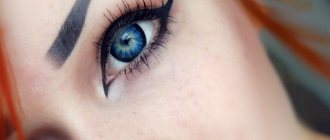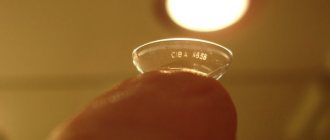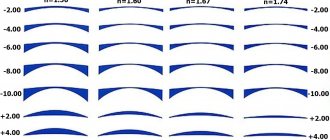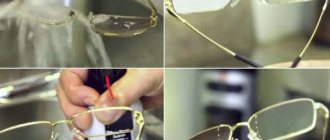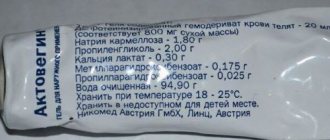Specifics of wearing mode
They must be used for at least 8 hours to achieve maximum effect.
If this condition is met, high visual acuity will be maintained throughout the day. The maximum effect occurs after 10-14 days of use. Compared to soft lenses, putting on and taking off hard contact lenses is fairly easy due to their fixed shape. When removing lenses, a special tool is used - a puller. The main rule that must be followed is hand hygiene. Before putting on and taking off, hands are thoroughly washed with soap and dried with a lint-free towel. Without following this rule, an eye infection may occur and further complications may develop.
Only after this can they be removed using a puller. The lens should be easy to remove.
During the initial period of wearing hard lenses, discomfort may occur and some optical disorders that are considered normal may occur (decreased vision clarity, double image, photosensitivity). As a rule, these symptoms eventually subside and vision returns to normal. If they do not go away, consultation with an ophthalmologist is required.
If you constantly experience unpleasant sensations (stinging, pain in the eyes, excessive lacrimation) while wearing orthokeratology lenses, you must remove the lenses and consult your ophthalmologist as soon as possible. Very often, this may indicate that the selected contact lenses are simply not suitable for you. Neglecting this rule can lead to serious complications. Also, do not wear lenses if you have a cold that is accompanied by a high temperature, as this can lead to the development of an eye infection due to a weakened immune system.
Features of use
The duration of use of LCDs depends not only on storage and cleaning, but also on proper donning and removal.
Step by step donning procedure:
Wash your hands thoroughly with neutral soap. Dry with a paper towel or a regular one, but without lint. Hygiene is important to prevent infections and reduces the likelihood of infection. Wipe both sides with soapy water and rinse with saline solution. Place on the tip of your index finger, add a drop of artificial tears
It is important to watch which side you are putting on to see if it is turned inside out. Some manufacturers indicate an indicator on the right side to make it easier to determine the position of the corrector
Use the middle finger of your second hand to push back the lower eyelid. Look up. Use your index finger to fix the upper eyelid in the desired position. Place on the cornea. Carry out the donning procedure in front of a mirror.
Discomfort or itching when starting to use contact lenses is considered normal. To prevent their appearance, after putting it on, it is recommended to look down with your eyes closed and not blink often.
It is important to follow these guidelines when wearing contact lenses:
- Do not use immediately after waking up. Wait 20 minutes. Remove 20–30 minutes before going to bed.
- Do not rinse with tap water. Use distilled.
- Don't sleep with your lenses on. The cornea needs rest.
- Moisten with artificial tears before removing. This way there is no risk of damaging the cornea.
- There is no need to use artificial tears during the day. But if you stay in a heated room for a long time or in a too cold room, using the solution will not hurt.
- Do not shower while wearing and remove before using the hot tub.
- Do not wear if there is prolonged discomfort, redness or redness of the eyelids, severe watery eyes, or if you are taking anti-allergy medications.
- Paste before applying makeup and do not use broken or cracked product.
- Sleeping with hard contact lenses is not recommended. This increases the risk of developing a corneal infection by 4 to 7 times. Sticks to the cornea.
- Remove if you have increased photosensitivity or blurred vision as a result of pathological processes or taking medications that cause this side effect. Such signs indicate oxygen starvation of the eye tissues; rest is required.
When you need to remove, wash your hands again with neutral soap and dry with a paper towel.
Apply artificial tears and carefully remove from the cornea
Complications
Patients who use OK lenses may experience complications. However, they are even less common than when wearing regular contact lenses.
What situations should alert night lens wearers? There are few of them:
- Redness of one or both eyes.
- The appearance of mucus or pus in the corners of the eyes.
- The occurrence of pain in the eye, photophobia, lacrimation.
If such symptoms are noticed, then wearing night lenses should be temporarily stopped. Any modern antibiotics - Floxal, Oftaquix or others - should be urgently instilled into the eyes (at least 5-6 times a day). In addition, you should definitely contact your doctor.
Correction range
Numerous studies report the possibility of 100% correction of myopia with nighttime OK lenses in the range of −1.5 to −4 diopters (D). However, there are reports of possible correction of myopia at −5 D. Moreover, in some patients it was possible to correct myopia at −6 D.
The greatest correction effect (up to 75%) of vision, as a rule, is achieved already during the first use of such lenses. Full correction and stabilization of results occurs by 7-10 days of using night lenses. During the day, when the lenses are not worn, there is a slight decrease in the effect, down to −0.75 diopters. Maintaining long-term vision correction requires the use of OK lenses every night or every 2 or 3 nights. Typically, patients are satisfied with wearing lenses night after night.
OK lenses have no age restrictions and are suitable for children and adolescents, which is very important, because surgical treatment of myopia cannot be performed before the age of 18. Such lenses are also suitable for adults who, for some reason, cannot undergo contact correction or have contraindications to surgical intervention.
Indications for wearing hard lenses
Soft and hard lenses differ in the specifics of their wear. For example, a soft lens is extremely comfortable and therefore ideal for everyday wear.
They do not cause discomfort, they can be worn at any time without experiencing negative feelings. But it will not be as durable if it is not constantly kept moist.
Gradually, such a lens dries out, it loses its flexibility, becomes brittle and is simply unsuitable for further wear.
Manufacturers are trying in every possible way to improve the service life of such lenses by adding various additional components to the material and treating the surface of the lenses in a special way, so modern soft lenses can still function for quite a long time.
Rigid lenses can be worn for a longer period of time. But they also require initially more serious adaptation.
At first, you need to get used to the fact that wearing them causes quite noticeable discomfort. But this is a necessary measure, because the result can be much better.
The fact is that hard lenses allow you to correct astigmatism, giving the cornea with impaired sphericity a more round surface. They should not be worn during intense activity, for example, when playing sports - it is better to wear soft ones, there is less chance that they will fly out and that a layer of dust and dirt will form under them.
You should also not wear them if you are extremely sensitive to bright light.
For night correction, you need to wear hard lenses. The principle of their operation is such that you put them on at night, during the night they have a corrective effect on the cornea of the eye, after which you walk around with good vision throughout the day. You should not wear such lenses during the day, just as you should not wear those types of lenses that are not designed for this at night.
The specifics of how to wear lenses depends not only on how soft or hard they are, but also on what the characteristics of a person’s vision problems are. So be sure not to experiment, but consult your doctor.
This type of contact lenses deserves to be discussed separately. You can get used to soft lenses, but not all people's eyes agree to put up with hypoxia.
Even if oxygen reaches the mucous membranes in some quantity, but not in full. After all, there are no blood vessels in the cornea, which means that oxygen cannot reach it through the blood.
The only way to get it is through the environment. And if a contact lens gets in the way, oxygen starvation occurs, accompanied by swelling and redness.
Drops and solutions
Since hard CLs contain hydrophobic groups, the solutions used for their treatment must have a low degree of viscosity and a fairly high penetrating ability. The percentage of cleaning, disinfecting, and moisturizing components in liquids for night lenses is higher than for soft ones. Therefore, special products are used to care for liquid crystals.
Important! The solution for gas-permeable lenses should not contain mercury salts or chlorine-containing components. Solutions for hard lenses include the following types:
Solutions for hard lenses include the following types:
- Boston Simplus.
- Sauflon One Step.
- Synergy.
- Delta Plus.
- Likontin-Forte.
Photo 1. Solution for hard contact lenses One Step, 360 ml, England.
There are also universal solutions that can be used for both hard and soft CLs:
- Comfort Vue.
- Cyclean.
- Sauflon 7.
- Universale Plus Multifaction.
- Vizoteque Pure Crystal and Verasol.
- Licontin-Neo-Multi.
Below are descriptions of some solutions:
- Synergy solution is intended for cleaning, moisturizing, disinfecting and storing contact lenses of all types. Suitable for sensitive eyes. Hypoallergenic. No preservatives.
- Sauflon One Step is a peroxide solution. It is a one-step peroxide system for cleaning contact lenses of any type: suitable for both soft and hard ones. The residence time in the solution is at least 8 hours!
- Universal solution Universale Plus Multiaction for cleaning, rinsing, disinfecting, storing and moisturizing contact lenses of all types. Manufacturer: Schalcon (Italy).
Reference! Moisturizing drops are not required when wearing gas permeable lenses, since the material is able to accumulate moisture. This property prevents drying out at high temperatures and in the wind. Drops can only be used when removing them (Avisor-360, Maxsima-300, Opti-Free-300).
Methods of cleansing
Contact lens care is carried out using the following methods: chemical, thermal and peroxide disinfection.
Thermal cleaning
This disinfection is carried out at high temperatures (about 80 degrees) using saline solutions. Processing is carried out for 20 minutes in a water bath (the optics are placed in a container resistant to high temperatures). Such cleansing allows you to get rid of many microorganisms. However, this method is rarely used, since constant heating negatively affects the optical characteristics.
Peroxide disinfection
It is carried out using a 3% solution of hydrogen peroxide. The positive aspects of this method are that hydrogen peroxide can destroy various bacteria and fungi, and this method is also suitable for people who are allergic to the components of cleaning solutions. However, you should be aware that such cleaning may not be effective enough (since not all microbes may die in a short time).
Chemical cleaning
For this method, special solutions are used that contain antimicrobial substances belonging to different chemical groups: oxidizing substances, acid, alcohol, mercury-containing. Cleaning is carried out by immersing the lenses in the solution for a certain time. The negative point of such disinfection is the following:
- If you do not keep the correction agent in the solution for the specified time, the effectiveness of such treatment will decrease.
- Sometimes a small amount of solution remains on the optics material, which, if it comes into contact with the eyes, can provoke an inflammatory process.
Storage and care
Rigid gas permeable lenses require special care. The material from which they are made contains hydrophobic groups that reduce wettability. To increase wettability, the surface must be treated using special technology. After processing, hydrophobic areas are formed on optical instruments, which attract proteins and some lipids from the tear fluid.
The attraction of lipids to the surface of lenses made of fluorine-containing material is much weaker. During use, a coating forms on them that does not penetrate deep into the material. Due to its occurrence, microorganisms receive an ideal environment for reproduction and can cause eye infections. To prevent it, it is necessary to use special liquids for disinfection (multifunctional for gas-permeable CLs), which help to disinfect and lubricate optical instruments. They remove protein deposits well using enzyme preparations. With their help, plaque is practically not formed, microorganisms are destroyed, and the wettability of the material becomes more effective.
The basic rules for caring for hard lenses are similar to the rules for caring for soft lenses:
- Before removing or putting on, be sure to wash your hands and dry with a lint-free cloth;
- Cover the CL completely with liquid and use only fresh solution;
- Do not reuse disinfectant liquid;
- Do not apply mechanical force: neither squeeze nor step on it.
A special container with claws is used to store rigid optical devices. They are in it
are suspended, the holding tabs allow you to keep the optics away from the walls of the container so that it does not touch them or get scratched.
When cleaning the contact lens, do not rub it too hard, as this may damage the outer layer. It is forbidden to subject them to heat treatment, because Heat may cause the lens to become deformed.
With proper care, contact correction devices will last longer and be more comfortable to wear. Proper operation can reduce the likelihood of eye infections and other complications.
Which lenses to choose
To ensure that wearing lenses does not cause discomfort and ensures high visual acuity, it is necessary to select contact lenses individually, taking into account the existing eye parameters. In addition to the required optical power, the radius of curvature of the lens surface (usually designated as BC), its thickness and water content in it (hydrophilicity), and the material of manufacture are important.
The most commonly used are soft contact lenses made from special polymer materials (hydrogel or silicone hydrogel). The most comfortable lenses to use are daily lenses, i.e. lenses whose wearing period does not exceed 7-10 hours. These lenses are the thinnest and have a high water content, but they are quite expensive.
There are certain indications for the prescription of rigid (gas-permeable) contact lenses (severe astigmatism, keratoconus). This type of contact lens has the highest oxygen throughput.
The selection of a specific type and type of contact lenses should only be carried out by a trained specialist after a detailed ophthalmological examination. When you first start using contact lenses, you may need moisturizing drops or drops that reduce corneal sensitivity to relieve eye adaptation symptoms. The more complex the lenses (toric, multifocal), the longer the adaptation period to them may be.
Most colored lenses are intended for people whose visual acuity is at least 6 diopters. You should be aware that colored contact lenses, especially long-wear ones, are not suitable for everyone, since the likelihood of allergies when using such lenses is greater than when wearing traditional contact lenses. For people with dark eye color, most of the colored contact lenses offered today will not be suitable for a radical change in the color of the iris, because... they are essentially tint.
Night lenses for vision correction - what are they and how do they work?
Orthokeratology (refractive therapy, OK therapy) is a modern technique for the temporary correction of refractive errors (myopia, astigmatism, hypermetropia) through the regular use of rigid gas permeable contact lenses (RCLs), which a person wears at night.
This vision correction technique can be used as an alternative to wearing glasses, daily contact lenses, and corrective surgical interventions. And it is also worth noting the unique ability of OK lenses to stop the progression of myopia in children and adolescents. These and other advantages of the method bring it to a leading position in contact vision correction.
The effect of vision restoration is achieved thanks to the special design of the orthokeratology lens. After putting it on the eye, redistribution and/or flattening of the epithelial cells of the cornea occurs. Thanks to hydraulic forces, according to the laws of physics, the central part of the cornea becomes flattened and its thickness increases along the periphery, which entails a change in its optical power and refractive power.
Scheme of changes in the shape of the cornea under the influence of an OK lens.
Important! Orthokeratological lenses do not violate the normal structure and integrity of the cornea of the eye, and the changes are so minimal that they can only be detected using a special device (keratotopograph), but they are effective enough for a person to see well without optical devices throughout the day.
Many people make the mistake of thinking that an orthokeratology lens puts pressure on the cornea. This is wrong. There is a thin layer of tear fluid between the inner surface of the product and the eyeball, so there is never direct contact between the GCL and the cornea. Otherwise, such interaction caused the development of keratitis (inflammation of the cornea).
Recent clinical studies have shown that in children who use nighttime treatment lenses to correct myopia, myopia progresses 2–4 times slower than in those who wear glasses or daytime soft or hard contact lenses.
The main disadvantage of vision correction using night lenses is the short-term effect. As a rule, after wearing LCDs overnight, the effect lasts no more than 24 hours, sometimes up to 48 hours.
Soft contact lenses
Nowadays large companies produce universal multifunctional complex products for cleaning, disinfecting and storing SCLs.
Daily cleaning of soft contact lenses is carried out as follows: place them on an open palm and apply a few drops of universal solution from the bottle, then gently wipe the surface of the lenses with your index finger and rinse with the same universal solution.
Using this product, daily disinfection of SCL is carried out. To do this, the old solution is poured out of the container, each contact lens is placed in the corresponding cell of the container and a fresh portion of the solution is poured into it so that it completely covers the lenses. Close the lid of the container and leave the lenses in it for at least 4 hours (usually overnight).
The disinfection procedure is repeated daily.
When using SCLs, they should be cleaned weekly or monthly with enzymes. To do this, wash both cells of the container for storing contact lenses with a universal solution and fill them with a fresh portion of this substance. Then one special tablet containing a cleaning enzyme is placed in each cell. Remove the lenses, rinse them with a daily cleaning solution, and then immerse the lenses in the enzyme solution.
Close both lids of the container and keep the lenses in the solution for 2 hours. Heavily soiled contact lenses require a longer soak time in the solution, but this period should not exceed 4 hours.
Rules for using night lenses
Like other types of corrective optics, hard lenses have their own wearing rules that must be strictly followed if you want to avoid vision problems.
How do orthokeratology lenses work?
The most important provisions of these rules are:
- Products that have chips or scratches should not be worn. They can damage the cornea.
- It is necessary to strictly observe the rules of hygiene for your optics. This will protect you from getting protein residues, microbes and fungi on the cornea.
- If any discomfort occurs while wearing lenses, you should immediately consult a doctor; normally, after the adaptation period, they should not occur.
- Lenses must not be given to strangers. This is an item for personal use, which is not recommended to be given even for trying on.
- When wearing such optics, you need to visit a doctor once every 3-4 months, even if you do not have any problems with wearing them.
Differences from soft
The possibilities of rigid contact optical devices are very wide. Most modern models meet the high requirements of owners and are easy to use.
The main advantages of hard lenses are:
- hold their shape well (dense material), thanks to which they maintain clarity and stability of the image;
- increased resistance to protein deposits that form due to tear fluid getting on the surface of the lenses;
- a smaller diameter that allows the extreme area of the cornea to be washed by tears and breathe;
- longer service life (with proper care);
- easier to put on and take off.
Despite the large number of advantages, there are also disadvantages:
- long adaptation (they are more difficult to get used to - it takes 5-7 days, and after a break you have to get used to it again);
- visible to the eyes, as they have a tint so that they are easy to find if lost;
- Some patients cannot use glasses after wearing hard contact lenses due to slight changes in the shape of the cornea.
Soft lenses are definitely more comfortable to wear. But manufacturing technologies do not stand still; manufacturers strive to create models that are not inferior in comfort to soft contact lenses. Many people do not face the question of choosing between hard and soft. They choose rigid models for safe wearing and vision correction.
Advantages
Hard contact lenses are an excellent option for people who cannot achieve ideal vision with soft contact lenses. Gas-permeable ones are better than soft ones. In addition to the ability to pass a high amount of oxygen, they have a lot of other positive properties.
Advantages of housing and communal services:
- Strength. Rigid optical devices hold their shape well due to the high density of the material. Less susceptible to deformation due to mechanical impact and blinking.
- The image remains stable and stable. The picture of the world is not distorted when blinking.
- Rigidity increases wear life. With proper care they will last for years.
- Resistant to protein deposits. This significantly saves processing time and increases the duration of use.
- Vision is better than with soft CLs.
- The LCL base does not contain water, so they rarely dry out, unlike hydrogel ones. You need to moisturize, but not as often as soft and hydrogel products.
- LCDs are more economical despite their high cost. They do not need to be changed monthly. A change is carried out if changes relate to deterioration of vision.
- The diameter is smaller than the cornea. This allows oxygen to flow to the peripheral zone and be washed with tears.
- Silicone-based LCDs provide better vision quality than soft ones. This advantage is especially noticeable when correcting astigmatism and high degrees of presbyopia.
LCDs are easier to handle because they do not tear or break. Such optical devices are easy to maintain and clean.
Gas permeable contact lenses are considered superior to regular hard ones. They provide the same vision correction, are durable and easy to maintain. However, there is one difference - they are safer. There is an exchange of oxygen and carbon dioxide.
Gas-permeable LCLs allow you to wash the surface of the eye, which significantly improves heat transfer. Doesn't dry out or cause irritation.
Selection rules
In order to choose the right contact lenses, you need to contact an ophthalmologist (preferably a specialized center for contact vision correction) so that the specialist can conduct a full examination and make a conclusion about the possibility or impossibility of using this type of correction.
An ophthalmological examination includes special methods for determining the quantity and composition of tears, as well as the patency of the lacrimal ducts. The eyelids are examined using optical instruments to rule out inflammation. In addition, the doctor, of course, determines the visual acuity of each eye, refraction, assesses the state of accommodation, examines the fundus, shape, thickness and sensitivity of the cornea, etc. Only after a thorough examination of the organ of vision, the doctor prescribes one or another type of contact lenses and teaches the patient how to use and care for them.
When selecting lenses in the contact correction room, the patient will be offered lenses to try on that are in sealed packaging, which will be opened in his presence.
A correctly selected lens should be located in the center of the eye, move freely with the index finger over the edge of the lower eyelid upward and quickly return to its original position.
How well the lenses are selected can be determined by personal feelings. The patient should experience comfort and notice an improvement in the quality of vision. Objective data obtained during subsequent examinations by an ophthalmologist will also help with this: for example, the presence or absence of redness of the eyes, mobility of the lens on the cornea when blinking, etc.
To what extent and in what ways are hard lenses safer than soft ones?
A look at the statistics
Many experts associate rigid gas permeable lenses primarily with excellent quality in the correction of complex types of refractive errors, such as high-grade astigmatism and keratoconus. But few people associate wearing such lenses with increased safety for users. How much safer they are than soft contact lenses is indicated by the statistics below.
Although the incidence of microbial keratitis (MK) among soft contact lens wearers averages 4 cases per 10,000 people per year, the rate is even lower among soft contact lens wearers, at 1.2 cases per 10,000 people per year1 . Considering that in Australia and New Zealand MC treatment costs an average of US$1228, annual cost savings would be US$41 million if all contact lens wearers worldwide switched to LGP. - lenses.
Moisture content of lenses and microbial activity
One of the most dangerous complications associated with wearing contact lenses is acanthamoeba keratitis. The risk of developing this disease is especially high in those who rinse their lenses and their storage container with tap water. What can be said about the risk of developing acanthamoeba keratitis in users of GP lenses?
Unlike soft contact lenses, which, depending on the material, can contain from 24 to 70% water, the moisture content of LGP lenses is only 1%. As you know, microorganisms need a warm and moist environment to thrive. Lack of moisture in LGP lenses leads to the death of harmful microorganisms, including Acanthamoeba. And yet, several species of Acanthamoeba have been identified, for example A. castellanii, which at a certain stage of their development are able to survive on GGP lenses. However, this danger can be easily eliminated by rinsing the lenses in a saline solution.
Inflammation of the cornea of the eye
While MK is considered an infrequent and very serious complication caused by wearing contact lenses and requiring the closest attention of doctors, inflammation of the cornea is a more common occurrence in the clinical practice of specialists in contact vision correction. Such inflammations include various types of keratitis, as well as acute red eye. One study found that corneal inflammation accounted for 34% of all adverse effects caused by contact lens wear.2 The researchers also found that corneal inflammation was less common among contact lens wearers than hydrogel and silicone hydrogel lens wearers.
Although the etiology of inflammatory processes in the cornea has not yet been fully studied, it has been noted that their development is often provoked by sleeping in lenses. Most often, such processes are caused by the microorganism P. aeruginosa, which easily attaches to the surface of hydrogel and silicone hydrogel lenses. However, as for LGP lenses, their surface is only slightly susceptible to contamination by this microorganism, regardless of whether the patient uses them for daily or extended wear.
The important role of tears in maintaining corneal health
There are strong arguments in favor of the fact that the development of corneal infections and inflammatory processes is associated with stagnation of tear fluid in the sublens space. Frequent tear exchange reduces the risk of complications, since the tear fluid washes microbes and various foreign particles from under the lens. With each blink, 10 to 20% of the tear fluid in the sub-lens space is renewed for users of HGP lenses, while for those who wear soft contact lenses, it is only 1-2%.3
The thickness of the tear film between the cornea and the silicone hydrogel lens is 2 microns, and under the influence of the eyelids when blinking, the film becomes even thinner. The tear film between the cornea and the LGP lens is much thicker - from 8 to 20 microns. The presence of a sufficient amount of tear fluid under the LGP lens allows the components of the tear to have a destructive effect on microorganisms. These components have also been found to mobilize the protective functions of corneal epithelial cells.
What about the limbus area?
All soft contact lenses available today interact in one way or another with the limbus area, for example, with their edges touching it. The limbal zone plays a very important role in maintaining corneal health because it is where stem cells are concentrated, the growth of which provides a rejuvenating effect.4 The use of hydrogel lenses with low oxygen transmission leads to the development of an undesirable process of neovascularization in the limbal zone. In addition, the mechanical impact of the edges of soft contact lenses on this area can damage the integrity of its epithelium. It is not yet entirely clear how dangerous this can be for stem cells.
Due to their small diameter, corneal (not scleral) ZGP lenses do not interact in any way with the limbus zone; accordingly, they cannot have any adverse effect on this zone. Of course, this is only true if the LGP lenses are correctly selected and have a good fit and centering on the cornea.
Are children allowed to wear it?
Modern hard models, for the most part, do not harm children's eyes in the form of dryness, burning and irritation. To prescribe this type of optics, it is necessary that the child is sufficiently independent and can properly care for the lenses. Already at 6-7 years old, a child can learn to put on and store optical devices.
In addition, the need to wear lenses arises if the baby has keratoconus. This is an eye disease in which the cornea takes on a cone shape due to thinning due to degenerative changes. Such changes are usually observed in adolescents, but can also occur in young children and even adults. The process of corneal deformation, in most cases, takes several years, although cases of rapid development of the disease are also observed.
The main method of vision correction for keratoconus is wearing hard contact lenses. They help correct the abnormal shape of the cornea and return it to normal. The presence of tear fluid between the cornea and the lens allows refraction of the surface of the eye.
Possible complications
The main reasons for the body's adverse reaction to the use of contact lenses are usually the patient's violation of the wearing regime, non-compliance with storage and handling conditions, and hygiene rules; lens damage; formation of deposits on them; the toxic effect of disinfectant and cleansing solutions, as well as incorrect selection of lenses by the doctor, and the initial pathological changes in the cornea not identified by him.
Complications include:
- Superficial keratitis that occurs when wearing lenses with defects (edge tears, scratches, etc.), as well as corneal erosions that form when gas-permeable liquid lenses are incorrectly selected (especially when worn for a long time). The main symptoms of superficial keratitis and erosions are lacrimation, photophobia, and blurred vision. Usually these phenomena go away when a person stops wearing damaged contact lenses.
- Allergic conjunctivitis. This disease is usually associated with intolerance to chemical cleaning and disinfection agents for SCLs, and less often with a reaction to the polymer materials from which the lenses are made. Allergens can also be deposits on lenses. As a result, itching, redness, and swelling of the cornea occurs, which is accompanied by decreased visual acuity and photophobia. If such phenomena occur, you should stop wearing lenses and consult a doctor.
Advantages of hard lenses
Modern liquid crystal lenses are not inferior to, and often superior to, soft lenses in gas permeability. In addition, they have a number of significant advantages, including:
- resistance to lipid and protein deposits;
- the ability not to dry out during prolonged work at the computer, in a dry or dusty room;
- long-term use, resistance to cracks and tears.
Removing the Lens
A few minutes after waking up, orthokeratology lenses should be carefully removed. You can do this as follows:
Special suction tweezers for easy lens removal after sleep
- Stand in front of a mirror, check the mobility of the lens: blink, look in different directions. If your eyes are dry, you should first apply moisturizing drops. If the products remain motionless, close your eyelids and massage your eyes a little.
- Using the index finger and middle finger of your free hand, lightly pull back your eyelids. Gently place the suction cup close to your eye, exactly in the center of the lens. Place the instrument against the optic and pull it lightly away from you. The lens should come off the cornea easily.
- If you fail to remove the product the first time, you do not need to make any effort to remove it using a suction cup. Apply a little more moisturizer, massage the eye, the optics should easily separate on their own.
How it works?
With myopia, light rays passing through the optical media of the eyes tend to focus in front of the retina. In order for the focus to fall on the retina, it is necessary to “weaken” the refraction of the rays. This is achieved by changing the shape of the cornea, which requires making it flatter. By the way, it is this principle that underlies most surgical methods of vision correction. Orthokeratology also uses it: hard lenses, pressing the cornea, make it flatter, as they provoke a redistribution of the surface layers of cells, which, in turn, refract light rays less easily, and the image is focused on the retina. After removing the night lenses, the cornea can retain its given shape for some time, and the patient sees well without any correction. But gradually the cornea straightens out to its original shape, and OK lenses have to be put on again.
What is ZhKL
Modern LCDs are gas permeable. The optical device is breathable and made of silicone. Such contact products allow you to see perfectly all day long and there is no need to frequently use artificial tears.
Corrects ophthalmological defects associated with changes in the shape of the cornea. They can be daytime or nighttime, and are allowed for children over a certain age and adults. The effect on the cornea is minimal and gentle, which has a positive effect on eye health.
Indications for use:
- scarring;
- consequences of injuries and eye surgeries;
- astigmatism;
- keratoconus;
- age-related farsightedness and myopia.
Rigid contact products are prescribed to people who need the highest possible visual acuity and improved peripheral vision. They are used by pilots, jewelers, surgeons and gynecologists.
It is recommended to be worn by people with myopia and for corneal refractive treatment.
Learning to handle liquid contaminants
There are two ways to put on hard contact lenses.
- Using the tip of the index finger of your right hand (when putting the lens on your right eye) or special tweezers, take the lens from the container with the solution so that it is concave surface up. Use the middle finger of your right hand to pull down the lower eyelid. Use the index finger of your left hand to lift the upper eyelid of your right eye. The gaze should be directed towards the lens. After this, you need to bring the lens closer to the center of the cornea and put it on the eye. Then slowly lower your eyelids.
The correct position of the lens on the cornea can be judged by visual acuity: if objects have clear outlines, the lens is put on correctly, but if the outlines are blurry, the lens is displaced on the cornea. Using the same principle, they put the LCD on the left eye, only the “main” hand is the left one. However, if it is inconvenient to use your left hand, you can use your right hand again.
- This method differs from the first only in the use of a mirror. Looking at your own reflection, it is easier to control your actions and you can see more clearly how correctly the lens is positioned on the cornea. If the lens is misaligned, you can adjust it through closed eyelids using your fingers or with open eyelids.
It is best to remove LCDs over a table, after placing a clean napkin on it (so as not to lose or damage the lenses). And this process can also be done in two ways:
- Tilt your head over the napkin. When removing the lens from the right eye, use the index finger of your right hand to press the ciliary edge of the upper eyelid in the center, and with the index finger of your left hand press the ciliary edge of the lower eyelid. When the index fingers move in the opposite direction, an air bubble enters under the lens and it easily falls out. Using a similar technique, you can remove the lens from your left eye by changing the position of your hands accordingly (left up, right down).
- Place your finger on the outer corner of the eye and pull the skin towards the ear. As a result, the eyelids, closing, will push the lens out of the cornea.
If the liquid lens has entered the area of the upper fornix of the eye, it is necessary to move the lens through the eyelids to the lower fornix and remove it from the eye using one of the indicated methods.
Tips for caring for lenses
The rules for caring for hard night lenses are quite similar to the rules for caring for soft lenses. For care, you will need a special storage container, special means for cleaning lenses and storing them.
Lenses are cleaned daily after removal. Pour a small amount of cleaner onto the removed lens and rub it with your fingers for a few minutes. The surface of the lens must be treated evenly. After cleaning, the lens should be rinsed with clean, warm water and placed in a storage container with a clean solution.
The lens is stored during the day in a special container in which the lens is placed in a vertical position. This container should always be kept clean. After putting on the lenses, the solution should be poured out of the container and rinsed with water, and then left to dry open overnight.
The selection of solutions for purification and storage is usually carried out by a doctor. It is not recommended to select products on your own, as this can lead to irritation of the eye mucosa, inflammatory processes and can damage the lens material. Also, you should not use solutions that are not intended for the care of orthokeratology lenses.
Disadvantages of lenses
You can wear hard lenses for no more than eighteen hours, then you need to remove them and place them in a special solution for lenses. If the instructions for use are not followed, the LCD can be scratched.
You should not sleep in them as they may stick to the cornea. It takes at least a week to get used to them. If you don't wear hard lenses for two days, you will have to get used to them again.
In some cases, after the patient has used hard lenses, the glasses no longer work. When putting on glasses, people note that their vision remains foggy and blurry. This happens because the lenses change the shape of the cornea. Over time, this defect disappears and the glasses become relevant again;
The selection process for hard lenses is complex. To do this, you need to visit an ophthalmologist, who will measure the parameters of the cornea using special equipment. Then, using reference lenses, the doctor will select the most suitable ones.
